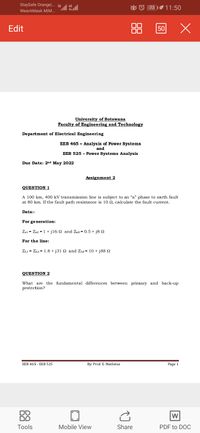
Introductory Circuit Analysis (13th Edition)
13th Edition
ISBN: 9780133923605
Author: Robert L. Boylestad
Publisher: PEARSON
expand_more
expand_more
format_list_bulleted
Concept explainers
Question

Transcribed Image Text:StaySafe Orangel. 36
O O 73
11:50
WearAMask M|..
Edit
88
50
University of Botswana
Faculty of Engineering and Technology
Department of Electrical Engineering
EEB 465 - Analysis of Power Systems
and
EEB 525 - Power Systems Analysis
Due Date: 2nd May 2022
Assignment 2
QUESTION 1
A 100 km, 400 kV transmission line is subject to an "a" phase to earth fault
at 80 km. If the fault path resistance is 10 2, calculate the fault current.
Data:-
For generation:
Zs1 = Zs2 = 1 + j16 N and Zs0 = 0.5 + j8 N
For the line:
ZLI = ZL2 = 1.8 + j31 2 and ZLO = 10 + j88 2
QUESTION 2
What are the fundamental differences between primary and back-up
protection?
EEB 465 - EEB 525
By: Prof. E. Matlotse
Page 1
DO
DO
W
Tools
Mobile View
Share
PDF to DOC
Expert Solution
This question has been solved!
Explore an expertly crafted, step-by-step solution for a thorough understanding of key concepts.
Step by stepSolved in 2 steps with 1 images

Knowledge Booster
Learn more about
Need a deep-dive on the concept behind this application? Look no further. Learn more about this topic, electrical-engineering and related others by exploring similar questions and additional content below.Similar questions
- A hydro powered 50 MVA generator, with a synchronous reactance 0.33 p.u., delivers 40 MW over a transmission line of 0.15 p.u. reactance to an infinite system. A 3-phase short circuit transient fault occurs on the busbar between the generator and transmission line. Given that the generator emf is 1.4 p.u. prior to and during the fault and all reactances are to a 50 MVA base: Sketch the single line schematic diagram of the system. Determine the maximum load angle the generator can swing to without losing stability. i) ii) iii) iv) Sketch the corresponding power-angle curve for the system showing the accelerating and decelerating areas. Calculate the critical clearing angle of the system to keep its stability.arrow_forwardQ2\ The one-line diagram of a simple power system is shown in figure below. All impedances are expressed in per unit (pu) on a common MVA base. All resistances and shunt capacitances are neglected. The generators are operating on no load at their rated voltage. A three-phase fault occurs at bus 1 through a fault impedance of Zf = j0.08 per unit. Using Thevenin's theorem obtain the impedance to the point of fault and the fault current in per unit. Determine the bus voltages and line currents of generators during fault. X₁ = = 0.1 XT-0.1 3 1 to ojo XL=0.2 2 040 X₁ = 0.1arrow_forward(b) A 30000 kVA, 13.8 kV generator with X = 18% is connected to a bus which supplies two identical motors as shown in the Figure 2. The subtransient reactance X of each motor is 25% on a base of 6000 kVA, 7 kV. The bus voltage at the motors is 7 kV when a three phase fault occurs at the point P. For the fault specified, determine (a) the subtransient current in the fault (b) the subtransient current in breaker A and (c) the symmetrical short circuit interrupting current in the fault and in breaker A. юю DO A P 0-0 Gen. Figure 2 Motorsarrow_forward
- A 3-phase generator has positive, negative, and zero-sequence reactance's of 0.30, 0.20, and 0.05 p.u. respectively. The generator is connected to a three-phase transformer Delta-Wye grounded with positive and negative sequence reactance of 0.10 p.u. and zero sequence reactance equal to 0.20 p.u. The transformer is connected to a transmission line having positive and negative sequence reactance of 10% and a zero-sequence reactance of 35%. The transmission line is connected to another Wye-Delta transformer and then to a three-phase load with each branch impedance being j1.0 and the neutral is grounded through a reactance of j1.0. A single line-to-line fault occurs at the end of the transmission line on phases B and C. a. Draw the sequence networks b. Compute the Sequence currents c. Compute the faulted phase currentsarrow_forwardIn a short circuit test on a 120 kV, 3 phase system, the breaker gave the following results: p.f. of fault 0.6, recovery voltage 0.9 times full line voltage, breaker current symmetrical, and restriking transient had a natural frequency 12 kHz. Determine average RRRV. Assume fault is grounded.arrow_forward
arrow_back_ios
arrow_forward_ios
Recommended textbooks for you
 Introductory Circuit Analysis (13th Edition)Electrical EngineeringISBN:9780133923605Author:Robert L. BoylestadPublisher:PEARSON
Introductory Circuit Analysis (13th Edition)Electrical EngineeringISBN:9780133923605Author:Robert L. BoylestadPublisher:PEARSON Delmar's Standard Textbook Of ElectricityElectrical EngineeringISBN:9781337900348Author:Stephen L. HermanPublisher:Cengage Learning
Delmar's Standard Textbook Of ElectricityElectrical EngineeringISBN:9781337900348Author:Stephen L. HermanPublisher:Cengage Learning Programmable Logic ControllersElectrical EngineeringISBN:9780073373843Author:Frank D. PetruzellaPublisher:McGraw-Hill Education
Programmable Logic ControllersElectrical EngineeringISBN:9780073373843Author:Frank D. PetruzellaPublisher:McGraw-Hill Education Fundamentals of Electric CircuitsElectrical EngineeringISBN:9780078028229Author:Charles K Alexander, Matthew SadikuPublisher:McGraw-Hill Education
Fundamentals of Electric CircuitsElectrical EngineeringISBN:9780078028229Author:Charles K Alexander, Matthew SadikuPublisher:McGraw-Hill Education Electric Circuits. (11th Edition)Electrical EngineeringISBN:9780134746968Author:James W. Nilsson, Susan RiedelPublisher:PEARSON
Electric Circuits. (11th Edition)Electrical EngineeringISBN:9780134746968Author:James W. Nilsson, Susan RiedelPublisher:PEARSON Engineering ElectromagneticsElectrical EngineeringISBN:9780078028151Author:Hayt, William H. (william Hart), Jr, BUCK, John A.Publisher:Mcgraw-hill Education,
Engineering ElectromagneticsElectrical EngineeringISBN:9780078028151Author:Hayt, William H. (william Hart), Jr, BUCK, John A.Publisher:Mcgraw-hill Education,

Introductory Circuit Analysis (13th Edition)
Electrical Engineering
ISBN:9780133923605
Author:Robert L. Boylestad
Publisher:PEARSON

Delmar's Standard Textbook Of Electricity
Electrical Engineering
ISBN:9781337900348
Author:Stephen L. Herman
Publisher:Cengage Learning

Programmable Logic Controllers
Electrical Engineering
ISBN:9780073373843
Author:Frank D. Petruzella
Publisher:McGraw-Hill Education

Fundamentals of Electric Circuits
Electrical Engineering
ISBN:9780078028229
Author:Charles K Alexander, Matthew Sadiku
Publisher:McGraw-Hill Education

Electric Circuits. (11th Edition)
Electrical Engineering
ISBN:9780134746968
Author:James W. Nilsson, Susan Riedel
Publisher:PEARSON

Engineering Electromagnetics
Electrical Engineering
ISBN:9780078028151
Author:Hayt, William H. (william Hart), Jr, BUCK, John A.
Publisher:Mcgraw-hill Education,